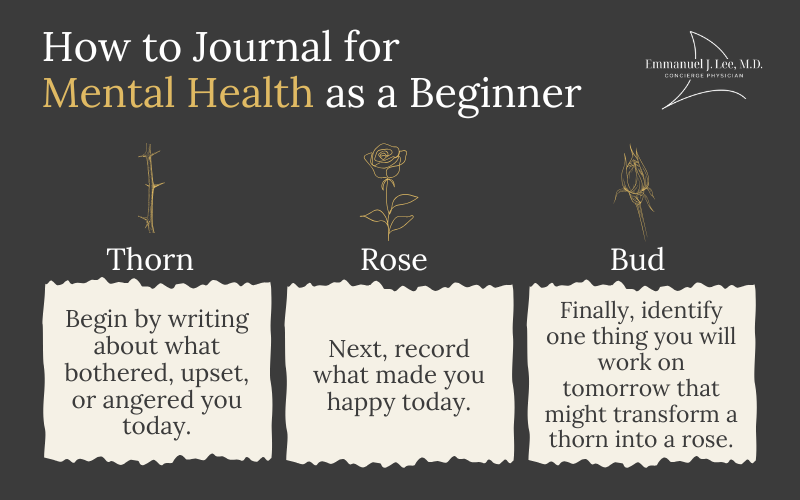External demands pull our attention in countless directions. We often find ourselves so caught up in responding to external forces that we lose sight of our individual selves. This disconnect contributes to feeling overwhelmed, which manifests as physical ailments and emotional distress.
While medical interventions have their place, I’ve come to appreciate how simple practices like journaling can complement conventional approaches to boosting mental health. Spending even five minutes a day looking inward and reflecting on your experiences can be transformative.
Learning how to journal for mental health and putting those lessons into practice can serve as a powerful antidote against modern stressors. Journaling creates dedicated time and space for introspection and reflection.

How to Journal for Mental Health: The Underlying Science
Journaling shares neurological pathways with other contemplative practices like meditation and forest bathing (or shinrin-yoku). These activities compel us to slow down, center our awareness, and shift from reacting to external stimuli to observing our internal landscape.
The physiological benefits of journaling are well-documented in medical literature. Regular journaling has been associated with decreased cortisol levels (a primary stress hormone) and increased production of endorphins, serotonin, and dopamine — neurotransmitters associated with improved mood and emotional regulation.
When we see what the scientific literature says about journaling for mental health, several benefits emerge:
- Reduced symptoms of anxiety and depression
- Improved emotional processing
- Enhanced self-awareness and emotional intelligence
- Better stress management capabilities
- Increased resilience to psychological distress
Journaling helps us recognize patterns in our thinking and behavior, providing a more nuanced perspective of our experiences. Writing about emotional events regulates our emotional response, reducing the intensity of negative emotions while preserving or even enhancing positive experiences.
Breaking the Emotional Bottleneck
Most people tend to keep certain emotions and thoughts inside. Many individuals find it challenging to, as therapists might say, “feel out loud.” This emotional containment is particularly common among men, who often receive cultural messages discouraging emotional expression.
When emotions remain unexpressed, they don’t simply disappear. Like water pressure building behind a clogged pipe, unexpressed emotions eventually find an outlet, often at inopportune moments or in ways that damage relationships and personal well-being.
Journaling is a controlled release valve for this emotional pressure. Though it isn’t a complete solution, the act of writing out fears, doubts, and worries provides a mechanism for expressing what might otherwise remain bottled inside. This expression often brings a sense of relief and partial closure to emotional challenges.
Beyond this emotional release, journaling requires thought about yourself and how you move through space and interact with others. This metacognitive aspect of journaling — thinking about your thinking — is a cornerstone of emotional intelligence and self-awareness.
Finding Your Personal Journaling Practice
Learning how to journal for mental health is a personal journey. For instance, rather than traditional pen-and-paper journaling, I practice what I call “mental cleansing,” a structured approach combining breathing exercises with verbal expression of both challenging emotions and gratitude.
During this practice, I verbally articulate things that are bothering me, upsetting me, or causing fear or worry. After acknowledging these feelings for 10–15 seconds, I remain present with them, observing that despite these challenges, I continue to exist and function. I then verbally express gratitude for positive aspects of my life, sitting with those feelings for another 10–15 seconds.
This practice reminds me that despite difficulties, I am not merely surviving, but thriving. I incorporate this brief ritual during otherwise unused moments (e.g., while driving to work or showering). Even these brief moments of reflection help my stress management.
Your own practice for mental health might look different. The key is finding what works for your personality, schedule, and preferences.

Simple Techniques: How to Journal for Mental Health as a Beginner
If you’re considering journaling but haven’t established a practice, here are some practical starting points.
For those new to journaling for mental health, I recommend a technique called “Rose, Bud, Thorn” that I learned through a primitive survival school:
- Thorn: Begin by writing about what bothered, upset, or angered you today. Document one thing or many — the quantity matters less than the honest expression.
- Rose: Next, record what made you happy today — positive experiences, joyful moments, or things for which you feel grateful.
- Bud: Finally, identify one thing you will work on tomorrow that might transform a thorn into a rose — a small, actionable step toward positive change.
This simple framework enables the writer to acknowledge challenges and balance them with positive reflection and forward-looking intention.
Overcoming Barriers to Consistent Journaling
When starting any new health practice, including learning how to journal for mental health, initial enthusiasm can give way to resistance. There may be days when journaling feels like a chore or times when you suffer from writer’s block (i.e., when you aren’t sure what to write).
Before you start, you may overthink the process itself. Rest assured: you don’t need an expensive leather-bound journal, a special fountain pen, or pristine environmental conditions to begin. A standard notebook and ballpoint pen are sufficient. The content of your reflection matters far more than the container it’s held in.
Another common barrier is setting unrealistic expectations. There’s no requirement to journal daily or produce pages of profound insights. Starting with even once-weekly journaling can establish a meaningful routine. When it comes to journaling for mental health, consistency proves more beneficial than frequency or volume.
Be honest with yourself about your practice, but also be kind. If you miss planned journaling sessions, simply return to the practice without self-judgment. Remember why you began journaling in the first place: to support your mental health, not to create another stress-generating obligation.
The Value of Written Records in Mental Health
One significant benefit of journaling for mental health is the creation of a tangible record. Unlike mental or verbal reflection, physical documentation allows you to review your thoughts and feelings from previous weeks or months, providing evidence of your psychological journey.
This record is a powerful way to identify patterns, track progress, and evaluate coping strategies’ efficacy. You can observe whether situations that once caused significant distress now feel manageable, or whether particular approaches to challenges have yielded positive results.
A written record also reinforces your resilience by demonstrating your capacity to navigate difficulties. During challenging periods, reviewing past entries can remind you of previous obstacles you’ve overcome and strengths you’ve demonstrated.
Integrating Journaling for Mental Health Into Your Broader Wellness Approach
While journaling offers substantial mental health benefits, it functions most effectively as part of a comprehensive approach to well-being. Consider how journaling might complement other practices:
- Using journaling to identify triggers for anxiety or low mood that you might discuss with a mental health professional
- Journaling before meditating to clear mental space
- Writing about physical sensations to better connect mental and physical awareness
- Documenting the effects of lifestyle changes on your mental state
- Recording moments of gratitude to build psychological resilience
Each of these applications extends the value of journaling beyond the writing itself, creating connections with other aspects of your mental health care.
How to Journal for Mental Health: Final Thoughts
Creating space for reflection through journaling offers a counterbalance to modern life’s incessant external demands. This practice doesn’t require elaborate tools or extensive time commitments — just a willingness to turn your attention inward with curiosity and compassion.
Whether you choose free-form, stream-of-consciousness journaling or guided prompts like Rose, Bud, Thorn, the key benefits of journaling for mental health arise from slowing down, expressing your emotions constructively, and building self-awareness. These qualities support not only mental health but overall well-being.
In my Austin, Texas-based practice, patients who learn how to journal for mental health often demonstrate improved resilience, emotional regulation, and clarity about their health priorities. While journaling alone can’t resolve serious mental health conditions, it represents a valuable complementary approach that supports psychological well-being alongside appropriate medical care.
If you’re interested in discussing how journaling might fit into your broader health strategy, I welcome the opportunity to explore this with you during your next appointment.






